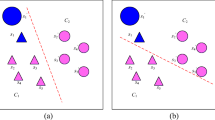Abstract
This paper presents a study of the Boosting Feature Selection (BFS) algorithm [1], a method which incorporates feature selection into Adaboost. Such an algorithm is interesting as it combines the methods studied by Boosting and ensemble feature selection researchers.
Observations are made on generalisation, weighted error and error diversity to compare the algorithms performance to Adaboost while using a nearest mean base learner. Ensemble feature prominence is proposed as a stop criterion for ensemble construction. Its quality assessed using the former performance measures. BFS is found to compete with Adaboost in terms of performance, despite the reduced feature description for each base classifer. This is explained using weighted error and error diversity. Results show the proposed stop criterion to be useful for trading ensemble performance and complexity.
Preview
Unable to display preview. Download preview PDF.
Similar content being viewed by others
References
Tieu, K., Viola, P.: Boosting image retrieval. IEEE Conf. on Computer Vision and Pattern Recognition, 228–235 (2000)
Freund, Y., Schapire, R.E.: Experiments with a new boosting algorithm. In Proc. 13th International Conference on Machine Learning, pp. 148–156 (1996)
Rätsch, G., Warmuth, M.: Maximizing the margin with boosting. In: Proceedings of the 15th Annual Conference on Computational Learning Theory, pp. 334–350 (2002)
Ho, T.: The random subspace method for constructing decision forests. IEEE Transactions on Pattern Analysis and Machine Intelligence 20, 832–844 (1998)
Cunningham, P., Carney, J.: Diversity versus quality in classification ensembles based on feature selection. In: Lopez de Mantaras, R., Plaza, E. (eds.) ECML 2000. LNCS (LNAI), vol. 1810, pp. 109–116. Springer, Heidelberg (2000)
Bryll, R., Gutierrez-Osuna, F.Q.: Attribute bagging: improving accuracy of classifier ensembles by using random feature subsets. Pattern Recognition 36, 1291–1302 (2003)
Guerra-Salcedo, C., Whitley, D.: Feature selection mechanisms for ensemble creation: a genetic search perspective. In: AAAI 1999 (1999)
Tsymbal, A., Pechenizkiy, M., Cunningham, P.: Diversity in search strategies for ensemble feature selection. Information Fusion 6, 83–98 (2005)
Günter, S., Bunke, H.: Feature selection algorithms for the generation of multiple classifier systems and their application to handwritten word recognition. Pattern Recognition Letters 25, 1323–1336 (2004)
Oza, N., Tumer, K.: Input decimation ensembles: Decorrelation through dimensionality reduction. In: Proc. of 2nd International Workshop on Multiple Classifier Systems, Cambridge, UK, pp. 238–247 (2001)
Brown, G., Wyatt, J., Harris, R., Yao, X.: Diversity creation methods: A survey and categorisation. Information Fusion 6, 5–20 (2005)
Quinlan, J.R.: Bagging, boosting and c4.5. In: Proceedings of the Thirteenth National Conference on Artificial Intelligence, pp. 725–730 (1996)
Schapire, R., Singer, Y.: Improved boosting algorithms using confidence-rated predictions. Machine Learning 37, 297–336 (1999)
Kuncheva, L., Whitaker, C.: Measures of diversity in classifier ensembles. Machine Learning 51, 181–207 (2003)
Feiss, J.: Statistical methods for rates and proportions (1981)
Blake, C., Merz, C.: UCI repository of machine learning databases (1998)
Skurichina, M., Kuncheva, L.I., Duin, R.P.W.: Bagging and boosting for the nearest mean classifier: Effects of sample size on diversity and accuracy. In: Roli, F., Kittler, J. (eds.) MCS 2002. LNCS, vol. 2364, pp. 62–71. Springer, Heidelberg (2002)
Freund, Y., Schapire, R.: A decision-theoretic generalization of on-line learning and an application to boosting. Journal of Computer and System Sciences, 119–139 (1997)
Schapire, R., Freund, Y., Bartlett, P., Lee, W.: Boosting the margin: A new explanation for the effectiveness of voting methods. The Annuals of Statistics, 1651–1686 (1998)
Author information
Authors and Affiliations
Editor information
Editors and Affiliations
Rights and permissions
Copyright information
© 2005 Springer-Verlag Berlin Heidelberg
About this paper
Cite this paper
Redpath, D.B., Lebart, K. (2005). Observations on Boosting Feature Selection. In: Oza, N.C., Polikar, R., Kittler, J., Roli, F. (eds) Multiple Classifier Systems. MCS 2005. Lecture Notes in Computer Science, vol 3541. Springer, Berlin, Heidelberg. https://doi.org/10.1007/11494683_4
Download citation
DOI: https://doi.org/10.1007/11494683_4
Publisher Name: Springer, Berlin, Heidelberg
Print ISBN: 978-3-540-26306-7
Online ISBN: 978-3-540-31578-0
eBook Packages: Computer ScienceComputer Science (R0)




